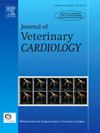经导管Amplatz犬导管闭塞器置入治疗动脉导管未闭:回顾性分析200只犬的预后和并发症
IF 1.3
2区 农林科学
Q2 VETERINARY SCIENCES
引用次数: 0
摘要
Amplatz犬导管闭塞器(ACDO)通常用于动脉导管未闭(PDA)闭塞。关于ACDO装置放置的临床结果和成功率的数据有限。本研究的目的是确定大群狗的ACDO对PDA闭塞的手术结果和并发症。动物、材料和方法回顾性研究了2007年3月至2023年9月期间200只接受ACDO放置治疗PDA闭塞的犬。在闭塞前、闭塞后24小时和随访复诊期间进行经胸超声心动图检查。手术成功的定义是根据PDA闭塞手术时的透视和手术后的存活来确定器械放置的成功。结果狗的中位体重为6.5 kg,需要的中位装置尺寸为6 mm。在闭塞24小时后,5%的狗有轻微的血流通过装置。在中位随访时间为96天的患者中,5.5%的患者在复查时发现持续的琐碎血流。2.5%的狗出现轻微并发症。4%的狗出现了主要并发症,其中2%的狗出现了器械栓塞。手术死亡率为0.5%。在术后24小时复查超声心动图(P<0.001)和随访复查(P<0.001)时,左室和左房尺寸均有统计学意义的减小。在选择设备尺寸时,超声心动图和血管造影测量和比值之间存在统计学差异(P<0.050)。结论ACDO器械手术成功率高,并发症发生率低,是一种安全有效的犬PDA闭塞治疗方法。本文章由计算机程序翻译,如有差异,请以英文原文为准。
Transcatheter Amplatz canine duct occluder placement for patent ductus arteriosus occlusion: A retrospective analysis of outcomes and complications in 200 dogs
Introduction
The Amplatz canine duct occluder (ACDO) is routinely used for patent ductus arteriosus (PDA) occlusion. Limited data are available on clinical outcomes and success rates with ACDO device placement. This study aimed to determine procedural outcome and complications for PDA occlusion with the ACDO in a large cohort of dogs.
Animals, Materials, and Methods
A retrospective study of 200 dogs that underwent ACDO placement for PDA occlusion between March 2007- and September 2023 was conducted. Transthoracic echocardiography was performed prior to occlusion, 24 h after occlusion, and during follow-up recheck visits. Procedural success was defined as successful device placement as determined based on fluoroscopy at the time of the PDA occlusion procedure and survival after the procedure.
Results
Dogs had a median weight of 6.5 kg and required a median device size of 6 mm. At 24 h post- occlusion, 5% of dogs had trivial flow through the device. Persistent trivial flow was noted on recheck in 5.5% of patients with a median follow-up time of 96 days. Minor complications occurred in 2.5% of dogs. Major complications occurred in 4% of dogs including device embolization in 2% of dogs. Procedural mortality rate was 0.5%. There was a statistically significant reduction in left ventricular and left atrial size at the 24-h postocclusion recheck echocardiogram (P<0.001) and at follow-up rechecks (P<0.001). There was a statistical difference (P<0.050) between echocardiographic and angiographicderived measurements and ratios when selecting device size.
Conclusions
The high procedural success and low complication rates support use of the ACDO device as a safe and effective method of PDA occlusion in dogs.
求助全文
通过发布文献求助,成功后即可免费获取论文全文。
去求助
来源期刊

Journal of Veterinary Cardiology
VETERINARY SCIENCES-
CiteScore
2.50
自引率
25.00%
发文量
66
审稿时长
154 days
期刊介绍:
The mission of the Journal of Veterinary Cardiology is to publish peer-reviewed reports of the highest quality that promote greater understanding of cardiovascular disease, and enhance the health and well being of animals and humans. The Journal of Veterinary Cardiology publishes original contributions involving research and clinical practice that include prospective and retrospective studies, clinical trials, epidemiology, observational studies, and advances in applied and basic research.
The Journal invites submission of original manuscripts. Specific content areas of interest include heart failure, arrhythmias, congenital heart disease, cardiovascular medicine, surgery, hypertension, health outcomes research, diagnostic imaging, interventional techniques, genetics, molecular cardiology, and cardiovascular pathology, pharmacology, and toxicology.
 求助内容:
求助内容: 应助结果提醒方式:
应助结果提醒方式:


